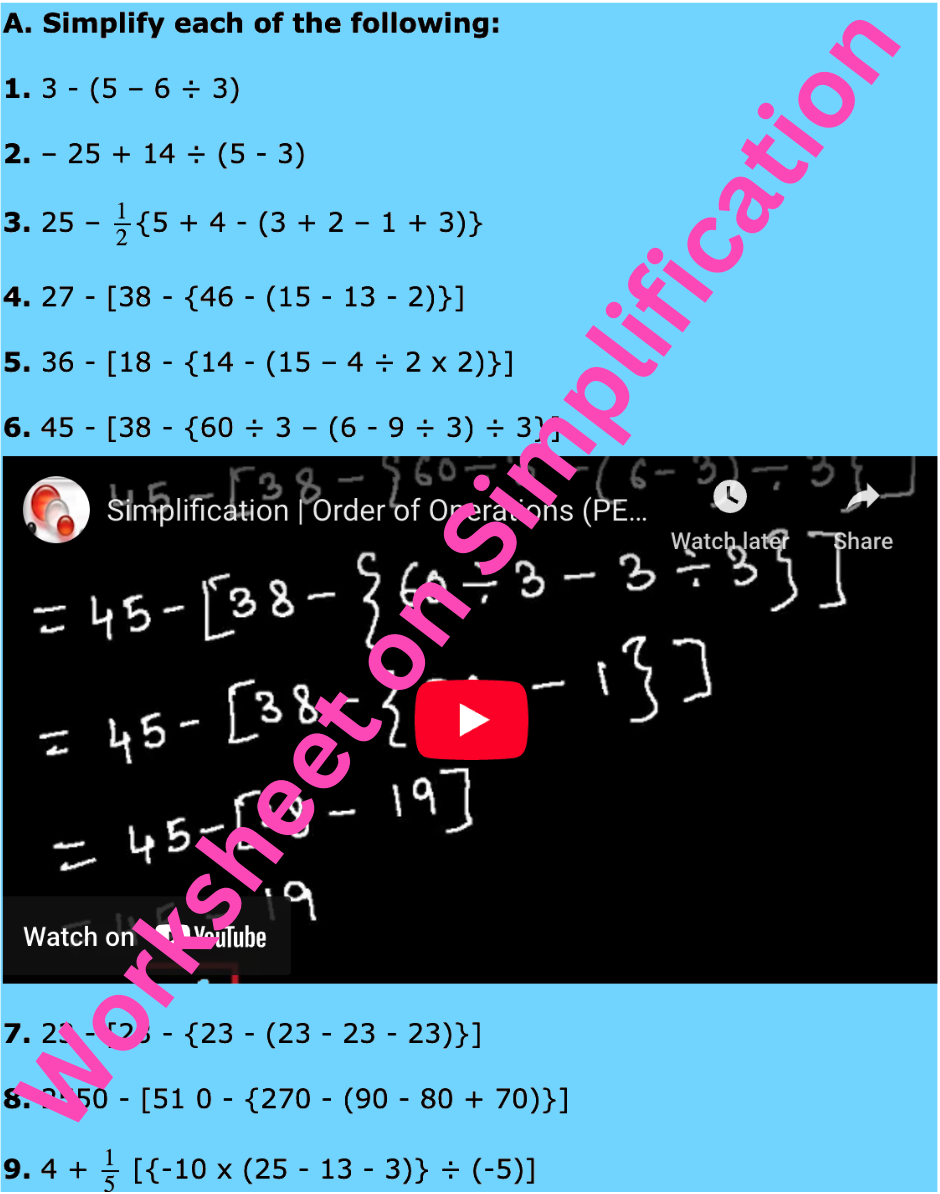Division of Literals
Division of literals obeys all operation of division of numbers.
In arithmetic, we have studied that the division sign ‘÷’ read as ‘by’ between two numbers means that the number on the left of the division sign is to be divided by the number on the right.
For example:
15 ÷ 3 means that the number 15 on the left of the division sign is to be divided by the number 3 on the right of division sign.
In the case of literal numbers also x ÷ y read as ‘x by y’ means that the literal x is to be divided by the literal y and is written as x/y.
Thus 25 divided by a is written as 25/a and y divided by 5 written as y/5. It should be noted that 1/5 of y or y divided by 5 is also written as y/5.
Similarly, x divided by 10 is x/10. Quotient of 5 by z is 5/z.
Examples on Division of Literals:
Write each of the following phrases using numbers, literals and the
basic operations of addition, subtraction, multiplication and
division:
1. Quotient of x by 4 is added to y.
Solution: We have,
Quotient of x by 4 = x/4
Therefore, quotient of x by 4 added to y = x/4 + y
2. Quotient of z by 6 is multiplied by y.
Solution: We have,
Quotient of z by 6 = z/6
Therefore, quotient of z by 6 is multiplied by y = z/6 × y = zy/6
3. Quotient of x by y added to the product of x and y.
Solution: We have,
Question of x by y = x/y
And product of x and y = xy
Therefore, quotient of x by y and to product of x and y = x/y + xy.
4. 100 taken away from the quotient of 5m by 2x.
Solution:
We have,
Quotient of 5m by 2x = 5m/2x.
Therefore, 100 taken away from the quotient of 5m by 2x = 5m/2x - 100
5. Product of 4 and a divided by the difference of 5 and a.
Solution: Product of 4 and a = 4a
Difference of 5 and a = (5 - a)
Thus, we have 4a ÷ (5 - a)
or, 4a/(5 - 4)
6. Express the share of each child algebraically if x apples were equally distributed among four children.
Solution: Total number of Apple = x
Number of children = 4
Therefore, each children gets x ÷ 4 = x/4 apples.
7. Quotient of x by 2 subtracted from 10 less than x
Solution: We have,
Quotient of x by 2 = x/2
10 less than x = (x - 10)
Thus, we have (x - 10) - x/2
Properties of Division of Literals
For any literal number a
(i) a ÷ a = 1
(ii) 0 ÷ a = 0
(iii) a ÷ 1 = a
Division of literals is neither commutative nor associative.
From From Division of Literals to HOME PAGE to HOME PAGE
Didn't find what you were looking for? Or want to know more information about Math Only Math. Use this Google Search to find what you need.
Recent Articles
-
Counting Numbers from 1 to 50 | Match the Number | Missing Numbers
Apr 04, 25 03:46 PM
In counting numbers from 1 to 50, recognize the numbers, count and then join the numbers in the correct number order. Here we mainly need eye-hand coordination to draw the picture and maintain the num -
Counting Eleven to Twenty with Numbers and Words |Numbers from 11 - 20
Apr 04, 25 03:21 PM
Counting eleven to twenty with numbers and words are explained below. One ten and one more is eleven. Eleven comes after ten. One ten and two more is twelve. Twelve comes after eleven. -
5th Grade BODMAS Rule Worksheet | PEMDAS | Order of operations|Answers
Apr 03, 25 03:11 PM
In 5th Grade BODMAS Rule Worksheet you will get different types of problems on mathematical expressions involving different operations, mathematical expression with 'brackets' and 'of' and simplifying… -
Worksheet on Simplification | Simplify Expressions | BODMAS Questions
Apr 03, 25 02:58 PM
In worksheet on simplification, the questions are based in order to simplify expressions involving more than one bracket by using the steps of removal of brackets. This exercise sheet -
Divisible by 2 Video |Test of Divisibility by 2 Trick| Rules| Examples
Apr 03, 25 10:25 AM
A number is divisible by 2 if the digit at unit place is either 0 or multiple of 2. So a number is divisible by 2 if digit at its units place is 0, 2, 4, 6 or 8.
● Literal Numbers - Worksheets
Worksheet on Addition of Literals
Worksheet on Subtraction of Literals
Worksheet on Multiplication of Literals
Worksheet on Division of Literals





New! Comments
Have your say about what you just read! Leave me a comment in the box below. Ask a Question or Answer a Question.